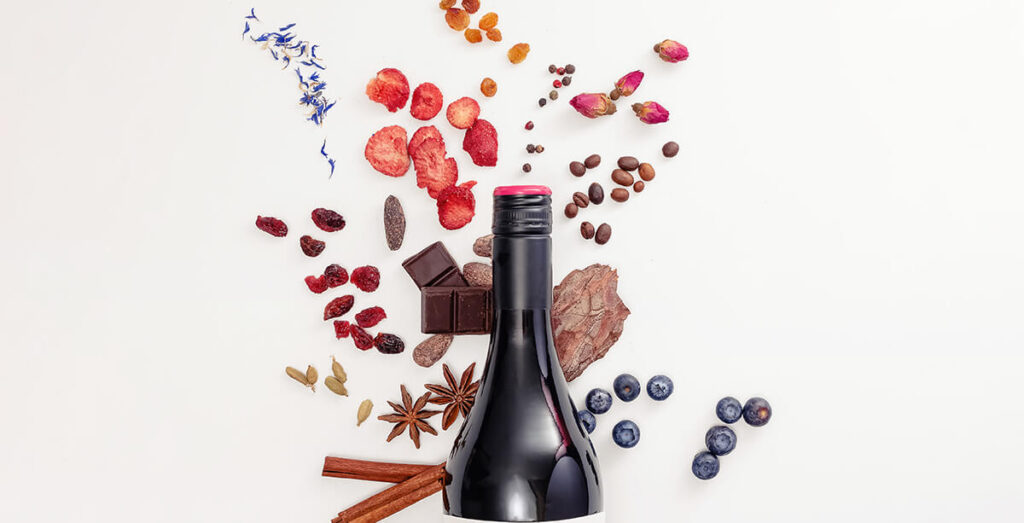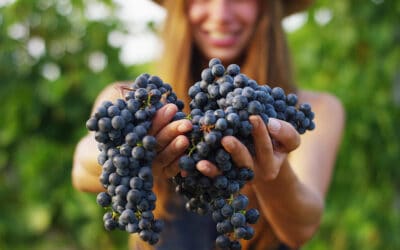Prepare to embark on a sensory odyssey as you uncover the seven exquisite tannin transformations that elevate aged French wines to the pinnacle of oenological art. From the gradual polymerization that imbues the wine with depth and complexity, to the oxidative process that yields an intoxicating bouquet of leather, truffle, and dried fruits, each transformation is a hallmark of the winemaker’s artistry. Witness the delicate dance of precipitation, softening, and flavor integration, as tannins shed their rough edges and intertwine seamlessly with the wine’s myriad flavors and aromas. The result is a transcendent elixir that captivates the senses and stirs the soul, inviting you to explore its mysteries further.
Polymerization
As French wines age, tannin molecules link together in longer and longer chains through the process of polymerization. You’ll find that this gradual transformation imbues the wine with an unparalleled depth and complexity, as the astringent bite of young tannins mellows into a velvety smoothness that caresses your palate. The once-harsh edges soften, allowing the wine’s true character to shine through in a symphony of flavors that dance upon your tongue.
Polymerization is a slow, almost mystical process, occurring in the quiet depths of the cellar as the wine slumbers. Over months and years, the tannins intertwine, creating intricate structures that lend the wine a newfound elegance and grace. It’s a metamorphosis that can’t be rushed, a monument to the virtues of patience and the artistry of the winemaker.
As you savor a glass of aged French wine, take a moment to appreciate the complex tapestry woven by polymerization. Each sip is a journey through time, a celebration of the wine’s evolution and the exquisite balance that can only be achieved through the passage of years.
Oxidation
Oxidation, another essential process in the aging of French wines, occurs when minute amounts of oxygen seep through the barrels’ pores, gradually transforming the wine’s color, aroma, and flavor profile.
As you savor a glass of aged Bordeaux or Burgundy, you’re experiencing the magnificent results of this slow dance between wine and air. The tannins, once harsh and astringent, have mellowed and softened, intertwining with the wine’s fruit flavors to create a symphony of balance and complexity on your palate.
Picture the deep garnet hues of a well-aged Pomerol, its color a record to the years spent in oak, allowing oxygen to work its magic. Breathe in the intoxicating bouquet, a tapestry of leather, truffle, and dried fruits, all thanks to the patient process of oxidation.
Each sip reveals new layers of flavor, the wine’s components seamlessly integrated, a masterpiece crafted by time and the winemaker’s expertise. Oxidation, a humble yet crucial aspect of the aging process, elevates these French wines to the pinnacle of oenological art, gifting us with elixirs that captivate our senses and ignite our souls.
Precipitation
Precipitation, the formation of solid particles within the wine, is another key transformation that occurs during the aging process. As you savor a glass of aged French wine, you’re witnessing the exquisite dance of tannins, proteins, and pigments that have gracefully coalesced over time, creating a masterpiece of flavor and complexity.
These delicate particles, born from the intricate interplay of the wine’s components, slowly descend through the liquid, leaving in their wake a wine of unparalleled clarity and brilliance. The once-astringent tannins, now softened and refined, impart a velvety caress upon your palate, while the muted hues whisper tales of the wine’s journey through the years.
With each sip, you’re not merely tasting a wine, but experiencing a chronicle to the artistry of time itself. The precipitation process, a delicate balance of chemistry and patience, has yielded a wine that’s both a sensory delight and a profound reflection of the vineyard’s terroir and the winemaker’s devotion. In this moment, as the wine dances upon your tongue, you’re partaking in a celebration of the beauty and complexity that only time can bestow.
Softening
Hand in hand with precipitation, the softening of tannins transforms the wine’s texture and mouthfeel over time. As you savor an aged French vintage, you’ll undoubtedly notice the remarkable evolution of its tannins—once firm and assertive, now gracefully mellowed and integrated. This gradual softening is a testament to the wine’s journey, a beautiful metamorphosis that unfolds within the confines of the bottle.
The astringent bite of youth gives way to a velvety caress, as the tannins shed their rough edges and embrace a newfound elegance. Each sip reveals a tapestry of smooth, supple sensations, inviting you to linger and explore the depths of the wine’s character. The once-bold structure hasn’t disappeared but rather evolved, providing a harmonious framework for the myriad flavors to dance upon your palate.
This softening is a delicate and intricate process, a pas de deux between time and tannin, orchestrated by the wine’s inherent chemistry and the patient hand of nature. As you revel in the luxurious texture of an aged French wine, pause to appreciate the extraordinary transformation that has taken place, a true marvel to behold.
Flavor Integration
As tannins soften and evolve, they intertwine with the wine’s complex tapestry of aromas and flavors, creating a harmonious and integrated sensory experience. You’ll discover that these transformed tannins, now supple and refined, have become an integral part of the wine’s overall profile, enhancing and elevating each nuanced note.
The once-astringent tannins have metamorphosed into velvety threads that weave through the rich fabric of the wine, binding together the myriad of flavors in a sublime symphony. As you savor each sip, you’ll uncover how the tannins have melded seamlessly with the fruit, oak, and earthy undertones, creating a profound depth and complexity that’s nothing short of enchanting.
This exquisite integration of tannins and flavors is a hallmark of the winemaker’s artistry and the patience required to allow the wine to mature gracefully. It’s a delicate dance, a perfect balance achieved through years of careful cellaring, and the result is a wine that’s not merely a sum of its parts, but a transcendent elixir that captivates the senses and stirs the soul.
Color Stability
While tannins evolve and integrate with the wine’s flavors, they also play an essential role in stabilizing the wine’s color over time. As you marvel at the resplendent hues of your aged French wine, you can’t help but appreciate the complex interplay between tannins and anthocyanins, the pigments responsible for the wine’s captivating alluring color. Through a process called copigmentation, tannins form stable complexes with anthocyanins, shielding them from oxidation and preserving the wine’s vibrant appearance.
Moreover, the gradual polymerization of tannins over time contributes to the formation of long-lasting pigments, ensuring that your treasured French wine maintains its enchanting alluring color for years to come.
As you swirl the glass and admire the deep crimson or amber tones, you’re witnessing the culmination of a delicate dance between tannins and color compounds, a representation demonstration of the winemaker’s artistry and nature’s incredible alchemy. With each sip, you’re not only savoring the exquisite flavors but also appreciating its visual splendor, making your aged French wine an unforgettable sensory experience that will linger in your memory for a lifetime.
Mouthfeel Evolution
Over time, the tannins in your aged French wine undergo a remarkable transformation, directly influencing the wine’s mouthfeel and texture. As the years pass, these astringent compounds, once harsh and unyielding, begin to soften and mellow, their rough edges polished by the inexorable march of time.
The result is a wine that caresses your palate with an unparalleled silkiness, a velvety embrace that envelops your senses and transports you to a domain of pure sensory bliss.
The evolution of tannins is a slow dance, a pas de deux between the wine and the oak, the fruit and the air. With each passing year, the tannins integrate ever more seamlessly with the other components of the wine, creating a harmonious whole that’s far greater than the sum of its parts.
The once-bold structure of the wine now serves as a graceful framework, supporting an intricate tapestry of flavors and aromas that unfold like a flower in the sun. As you savor each sip, you can’t help but marvel at the exquisite beauty and complexity that can only be achieved through the patient art of aging.
Explore an Alchemy of Tannins
As you savor an aged French wine, ponder the mesmerizing alchemy of tannin’s septuple metamorphosis—a dance of polymerization and oxidation, precipitation and softening, flavor integration and color stability, and mouthfeel evolution—that, in felicitous harmony, helps sculpt the elixir’s very essence.
With each sip, you partake not merely of fermented grape, but of a profound chronicle to time’s power to transmute the astringent into the ambrosial, the unrefined into the quintessential.




0 Comments